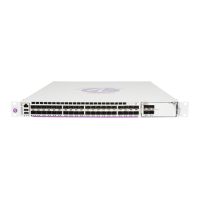IP Router Configuration
7705 SAR OS Router Configuration Guide 41
Bidirectional Forwarding Detection (BFD)
BFD is a simple protocol for detecting failures in a network. BFD uses a “hello” mechanism
that sends control messages periodically to the far end and receives periodic control messages
from the far end. BFD is implemented for routes in asynchronous mode only, meaning that
neither end responds to control messages; rather, the messages are sent in the time period
configured at each end.
Due to the lightweight nature of BFD, it can detect failures faster than other detection
protocols, making it ideal for use in applications such as mobile transport.
If the configured number of consecutive BFD missed messages is reached, the route to the
peer is declared not active. For centralized and line card BFD sessions, failure detection is
propagated to all impacted upper layer protocols within a few milliseconds. Upper layer
protocols act on failure information as soon as it is made available by BFD.
The v-port on the 2-port 10GigE (Ethernet) Adapter card and on the 2-port 10GigE (Ethernet)
module is linked to the ring ports through the add/drop port, therefore its operational status—
always operationally up—is not dependent on the status of the ring ports. Hence, a ring port
failure will not necessarily trigger an action at the v-port. To ensure that there is fast detection
of any Layer 2 failure and that protocols on the v-port will react to the failure, you must run
health-check tests or OAM tests with the peer or peers at the far end. For example, BFD must
be configured between the v-port and the far-end IP interface. The use of health-check tests
to the far-end interface will trigger upper layer protection mechanisms on the v-port, where
the behavior will be comparable to an intermediate Layer 2 transport network failure on any
other Ethernet port.
For IPv4, BFD is supported on static routes, OSPF, IS-IS, BGP, PIM, RSVP-TE, and T-LDP.
For IPv6, BFD is supported on static routes and OSPFv3.
NAT
Network Address Translation (NAT) is used by mobile backhaul, enterprise, and SI (Strategic
Industries) providers to provide expandability and security for private networks. Tier 1
providers can potentially run out of private IPv4 addresses, making it difficult to expand their
existing networks. To address this issue, NAT can be used. NAT can hide multiple private IP
addresses behind a single public IP address and therefore makes it possible to scale IP
solutions in mobile backhaul, enterprise, and SI networks.

